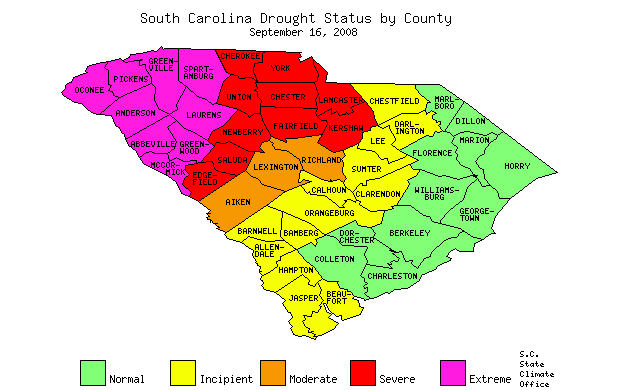
The purpose of the drought meeting is to evaluate the drought status statewide. The committee will review climatic data, streamflow and lake level data, and drought impacts. Local response to the on-going drought will also be reviewed to determine if additional actions are needed to insure sustainable water supplies.
If you have any questions, please contact me at 803-734-9568 or email me at mizzellh@dnr.sc.gov.

For previously issued drought statements see the archived status reports.
Table of all counties and drought status.The S.C. Department of Natural Resources convened the S.C. Drought Response Committee on September 16, 2008 in Greenville and nine Upstate counties remain in extreme drought. Ten counties were downgraded or maintained at severe and three remain at moderate status. Thirteen counties were downgraded to incipient status. Recent rains prompted the Drought Response Committee to remove the drought declaration for ten counties: Marion, Dillon, Marlboro, Florence, Horry, Williamsburg, Berkeley, Dorchester and Colleton. The drought declaration was removed for Georgetown and Charleston during the August meeting.
The counties remaining in the extreme category are: Oconee, Pickens, Greenville, Spartanburg, Anderson, Abbeville, Laurens, Greenwood and McCormick counties. For more information about drought and to see a drought status by county map, visit the Office of State Climatology Drought Website at: www.dnr.sc.gov/climate/sco/Drought/drought_current_info.php.
David Tompkins with the S.C. Department of Agriculture reported, "The impact of the drought on agriculture continues for parts of the state with significant concern over hay availability for our cattle industry."
The S.C. Forestry Commission cited a 9.55% increase in wildfires for July/August and a 66.4% increase in the number of acres burned compared to the five-year average. The Commission expects to have an active fall fire season.
Stan Simpson, US Army Corps of Engineers, provided a review of the Corps' operation of the Savannah River lakes in response to the drought explaining that Lakes Hartwell and Thurmond is expected to reach new record lows over the next 10 weeks.
Andy Wachob, DNR Hydrologist, reported all lakes around the state are below their target level except Lake Murray. He noted Jocassee, Hartwell and Thurmond lakes were the hardest hit by drought. He also spoke about the steady decline in most Upstate groundwater wells with a well in Spartanburg at a record low and a well in Oconee County near record low.
According to Mizzell, "We are entering the driest months climatologically, October-November, and without rainfall from tropical systems, rainfall amounts during these months can be very low."
Steve de Kozlowski, S.C. Department of Natural Resources (DNR) Land, Water, and Conservation Division Interim Deputy Director, stated, "Upstate water systems can ensure they maintain adequate supplies through rigorous conservation efforts."
DNR protects and manages South Carolina's natural resources by making wise and balanced decisions for the benefit of the state's natural resources and its people. Find out more about DNR at www.dnr.sc.gov. For more drought information contact State Climatologist Hope Mizzell in Columbia at (803) 734-9568 or e-mail MizzellH@dnr.sc.gov.
| Current Drought Status by County | ||||
|---|---|---|---|---|
| Normal | Incipient | Moderate | Severe | Extreme |
| County Status |
County Status |
County Status |
County Status |
County Status |
| ABBEVILLE Extreme |
AIKEN Moderate |
ALLENDALE Incipient |
ANDERSON Extreme |
BAMBERG Incipient |
| BARNWELL Incipient |
BEAUFORT Incipient |
BERKELEY Normal |
CALHOUN Incipient |
CHARLESTON Normal |
| CHEROKEE Severe |
CHESTER Severe |
CHESTERFIELD Incipient |
CLARENDON Incipient |
COLLETON Normal |
| DARLINGTON Incipient |
DILLON Normal |
DORCHESTER Normal |
EDGEFIELD Severe |
FAIRFIELD Severe |
| FLORENCE Normal |
GEORGETOWN Normal |
GREENVILLE Extreme |
GREENWOOD Extreme |
HAMPTON Incipient |
| HORRY Normal |
JASPER Incipient |
KERSHAW Severe |
LANCASTER Severe |
LAURENS Extreme |
| LEE Incipient |
LEXINGTON Moderate |
MARION Normal |
MARLBORO Normal |
MCCORMICK Extreme |
| NEWBERRY Severe |
OCONEE Extreme |
ORANGEBURG Incipient |
PICKENS Extreme |
RICHLAND Moderate |
| SALUDA Severe |
SPARTANBURG Extreme |
SUMTER Incipient |
UNION Severe |
WILLIAMSBURG Normal |
| YORK Severe |
||||
| SC Drought Response Committee Meeting, October 7, 2008 Sign-In sheet | |
|---|---|
| Name & Agency | Name & Agency |
|
Nick Anastos - Citizen Ann Soenen - Citizen - River Bluff Community Doug Pierce - Citizen Steven J. de Kozlowski - SCDNR Stan Simpson - US Corps of Engineers Charlie Sowell - Greenville Journal John Baker - International Paper David Baize - SCDHEC Frank Eskridge - Greenville Water System Ed Jensen - Word News Scott Willett - Anderson Regional Water Stuart Ames - Drought Committee Doug Young Mitch Turner - SJWD Water District John Shelton - USGS Eric Strom - USGS Ken Forrester - SCDNR Warren Harris - Drought Committee Rick Jones - Town of West Union |
KC Price - Greenville Water System Jamie Bach - Governor's Office Connie Gawns - SCDNR Lee Mitchell - SCDNR Kirsten Lackstrom - University of South Carolina Becky Wooten Ed Hughes Margaret Richardson - EMD Lynne Newton Paul Alongi - Greenville News Steve Hammond - Duke Energy John Westcott - Drought Committee Gregory Lambouty - National Weather Service David Tompkins - SC Dept. of Ag George Gallegar - Duke Energy Nigel Roberton - WYFF Andrew Wachob - SCDNR Evelyn Johnson - SCDNR Hope Mizzell - SCDNR Brett Witt - SCDNR |
Find out more about the State Climatology Office at https://www.dnr.sc.gov/climate/sco/ or by calling (803) 734-9100.
